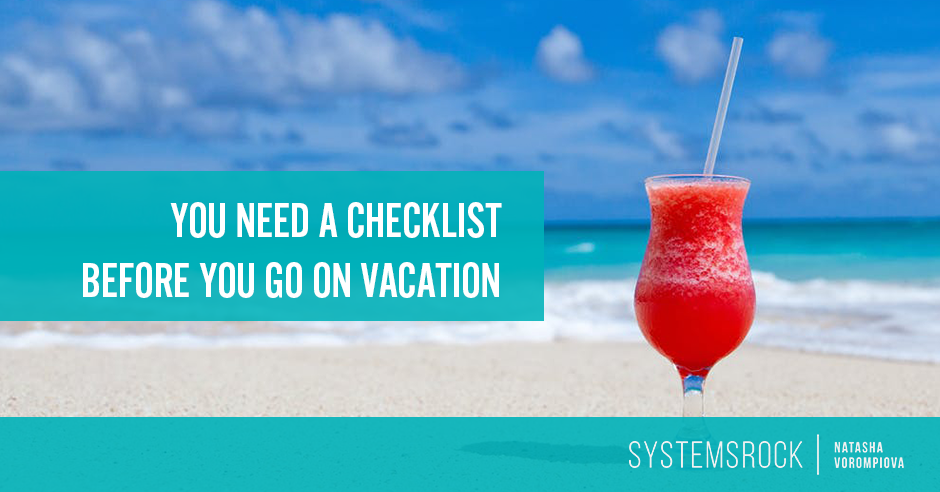 Did all sorts of fears creep up on you the last time you thought about taking a vacation?
Did all sorts of fears creep up on you the last time you thought about taking a vacation?
Can I go on vacation without ruining my business? Everything’s going to collapse if I’m not in control. I’m the only one who can keep things running smoothly. Maybe I should just keep working and take a vacation later.
While worrying is understandable, we must also remember the reasons we started our business in the first place!
We wanted a lifestyle that grants us flexibility and the freedom to enjoy our lives, our friends, and our families.
With the holidays right around the corner, it’s time we took a vacation so we can enjoy what matters most.
The best news?
Your business can run smoothly even when you’re on vacation.
Step #1: Communicate
Before you hide your laptop and start your vacation, make sure you give everyone a heads up.
Falling off the face of the Earth is not recommended here. ;]
Make a list of the people who need to know you’ll be away:
- Clients
- Virtual assistant
- Contractors
- Business partners
- Mastermind groups
- Friends
Then, you’ll want to do four things:
- Decide how long you want to be away
- Make a list of any unfinished projects
- Send everyone a quick email a few weeks in advance letting them know that you’re taking time off
Make sure to be specific about the dates so they know when to expect you back.
Here’s a sample message.
Hi [name]!
Just wanted to give you a heads up that I’ll be off for two full weeks beginning on December 23rd and ending on January 6th.
Are there any loose ends we need to tie up beforehand?
Much love,
Natasha
- Draft a vacation autoresponder for your email.
If you have several e-mail accounts, make sure you set up an autoresponder for each.
You can easily create a Gmail vacation autoresponder by going into Settings and then scrolling down to Vacation Responder where you can specify beginning and end dates as well as the subject line and body of the email.
Depending on which hosting service you use, this process will differ, but you should be able to log in to your hosting account and choose the term Autoresponders under the Email category.
Do people who reach out to you often have the same questions? If so, you might want to include your answers to a Frequently Asked Questions (FAQ) page on your site and link to it in your auto responder.
Autoresponder example:
Subject line: Natasha and the SystemsRock Team are on Holiday Break
Hi there,
Thanks for contacting us.
Right now, we’re taking a couple weeks off for the holidays, and we’ll be returning on January 6, 2015.
If you are getting in touch to discuss working with us, we’ll be sure to get back to you shortly after our vacation.
[Here you can talk a bit about an upcoming program or service] The Systematic Success Guide will be available January 2015, so if you want to get on the early list, sign up here.
If you’re inquiring about anything that’s time-sensitive, please resend your email to support@systemsrock.com with the subject line “Time Sensitive”.
Thanks for getting in touch!
Much love,
Natasha Vorompiova
P.S. Happy holidays!
You’ll be less inclined to check email during vacation and less worried about taking care of clients’ needs if you set up autoresponders like this.
Step #2: Batch
You’ll want to continue publishing your blog posts, newsletters and other types of content even though you’re on vacation.
Make a list of all of the regular activities you do, so you can do all of the prep work in advance.
Here’s an example.
Throughout the week, I publish:
- 1 new blog post
- 1 new podcast episode
- 3 tweets a day
- 1 Facebook post a day
- 1 newsletter
If I were to go on vacation for two weeks, then I would need to prepare:
- 3 blog posts
- 3 podcast episodes
- 48 tweets
- 16 Facebook posts
- 3 newsletters
I tripled the numbers because the last thing I want to do right after vacation is to scramble to get out content.
Then, in a project management system like Asana, choose a few days where you can write all of this content in one big batch, like writing three blog posts and three newsletters in one or a couple of days.
Batching will allow you to spend less time creating content because you won’t be wasting time and energy switching from content creation to another task, especially if those tasks are different in nature.
Your bonus—while on vacation, you won’t need to worry about your content being published on a regular schedule.
Step #3: Automate
Use tools to schedule things like blog posts, podcasts, and social media, so you can still share valuable content while you’re relaxing.
You already have a list of all of the items that you need to publish, so now you need to figure out if the tools you’re already using have prescheduling features built into them.
What tools could you use?
Blog Posts – WordPress makes it easy for you to preschedule your content to go live on a certain date and time.
Newsletters – E-mail management systems, like Mailchimp, AWeber, Ontraport, and Infusionsoft allow you to preschedule your newsletters for a certain date and time.
Social Media – Tools like Hootsuite, Buffer, and Social Sprout allow you to preschedule tweets, Facebook posts, LinkedIn posts, and Google Plus posts for specified dates and times.
Podcasts/Videos – Libsyn, the podcasting service, allows for prescheduling of episodes and YouTube videos can be prescheduled as long as you specify before uploading them.
Finally, if you’re using an online scheduler like ScheduleOnce, Schedulicity, Acuity Scheduling or TimeTrade, block your schedule for the time you will be away so that your clients don’t accidentally schedule themselves during that period.
Step #4: Optimize
If you have a team or a virtual assistant, now is the perfect time to revise your out-of-date workflows (also called standard operating procedures or SOPs), or documents that outline how certain tasks are accomplished in your business.
Here’s what you can do:
- Take note of which responsibilities each team member has
- Have them read through the SOPs that currently exist for each task
- Ask them to update the SOPs based on changes in processes
- Take a final look at those SOPs and make any necessary tweaks
- Test how your team member(s) can handle things without you by taking a day or two off (naturally, you’ll warn them; don’t just disappear on them)
If there are tasks that don’t have SOPs, ask your team members to create them.
Having up-to-date SOPs helps your team members feel empowered while you are away and gives them better tools to make smart decisions if they can’t ask you for the next step.
Learn to Let Go
Letting go of things isn’t going to be easy, so you have to prepare yourself, too.
You’re going to be tempted to keep checking your inbox and jumping in to solve an issue (that you’ve already taught your assistant how to handle).
Prepare to resist by creating boundaries for yourself and reminding yourself why you’re doing this.
It’s so you can unplug, relax, and enjoy!
Your business shouldn’t run your life. Take off your CEO stilettos for the holidays, and savor the lifestyle you’ve created for yourself.
Back to You
What items on the above checklist need your attention, so you can have a carefree, joyous holiday?


